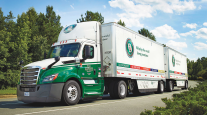Staff Reporter
TFI Q4 Profits Fall 14.4% as Deals Dull Freight Market Toll

[Stay on top of transportation news: Get TTNews in your inbox.]
Profits at TFI International in the fourth quarter fell 14.4% compared with the same period a year earlier, as acquisitions softened the impact of a weak freight environment.
Closing the largest of those acquisitions, Texas-based flatbed specialist Daseke, will be a key focus for TFI in 2024, as will turning around the company’s U.S. less-than-truckload operations, Chairman and CEO Alain Bédard said Feb. 9 during an analyst conference call.
The company posted net income of $131.4 million, or $1.53 per diluted share, in the final three months of 2023, compared with a $153.5 million, or $1.74, in the same period a year earlier, citing the weak freight environment.
TFI posted revenue of $1.97 billion in Q4, compared with $1.96 billion in the year-ago period, with acquisitions bolstering the figure, trumping a decline in volumes, it said. The company’s revenue before fuel surcharges in Q4 came in at $1.67 billion, compared with $1.62 billion a year earlier.
TFI inked 12 acquisitions in 2023. The final deal of the year — paying $1 billion for Daseke — was the biggest. Even before the deals, TFI ranked No. 4 on the Transport Topics Top 100 list of the largest for-hire carriers in North America.
A couple of the deals were for less-than-truckload companies — including Siemens Transportation Group and Hot Line Freight Systems — and the LTL division contributed 43% of TFI’s revenue in Q4.
RELATED: Outlook Brighter for Trucking M&A Market in 2024
The LTL division posted revenue of $846.4 million in Q4, compared with $903.7 million in the year-ago period, but a turnaround is underway at the U.S. operations, TForce Freight.
“The name of the game for us … is improved revenue as a result of improved service,” said Bédard, adding that the U.S. LTL unit’s operating ratio is unacceptable.
TFI’s U.S. LTL business posted an operating ratio of 91 in Q4, compared with 90.4 in the same period a year earlier. By comparison, TFI’s Canadian LTL unit posted an operating ratio of 79.9 in the most recent quarter, and even that was down compared with 75.3 in Q4 2022.
How does hydrogen fuel cell technology fit into freight transportation? Find out with Parker Meeks, the CEO of Hyzon, a company that designs and manufactures fuel cell technology for heavy-duty transport applications. Tune in above or by going to RoadSigns.ttnews.com.
Operating ratio provides insight on how well a company is balancing its costs and revenue generation. The lower the ratio, the better a company’s performance.
“Part of the plan is to stop shedding volume,” said Bédard, adding that actions had been taken to improve service through improved training, adding newer vehicles and cutting back on shipper claims.
“Our claims ratio is down like no tomorrow,” he said, adding that Canadian employees had been parachuted in to help remedy the situation.
TForce’s cargo claims as a percentage of revenue averaged 0.5% in the most recent quarter, compared with 1.5% in the same period a year earlier. By comparison, cargo claims at TFI’s Canadian LTL business held steady year-over-year in Q4 at 0.1%.
The average truck age for the company’s U.S. LTL business in the final three months of 2023 was 4.7 years, compared with 6.6 years in the same period a year earlier.
Want more news? Listen to today's daily briefing above or go here for more info
In the coming 12 months, TFI also intends to revamp the U.S. LTL unit’s information technology systems, turning it into something fit for the 21st century rather than the 1960s, Bédard said.
Already, the company replaced the Workday software system used by UPS Freight when TFI bought the business in 2021.
Legacy billing systems have hindered TForce since TFI bought the unit, said Bédard, arguing that the division’s peers do not have to deal with the same issues. “Our churn of customers is way too high,” he said.
Another program underway at the U.S. LTL operations is increasing the average weight per shipment, the executive said. Even after increasing the average weight per shipment 10% over the past couple of years to more than 1,100 pounds, Bédard remains underwhelmed, he said, noting peers’ average weight per shipment was above 1,500 pounds.
Part of the shift involves a larger share of shipments becoming industrial freight rather than retail freight. “Retail freight is good; industrial freight is better,” he quipped.
TFI also operates truckload, package and courier and logistics businesses, which contributed 24%, 8% and 25%, respectively, of the company’s revenues in Q4. TFI is considering spinning off the truckload business into a separate publicly traded company.
The unit’s specialized truckload operations posted an operating ratio of 87 in the most recent quarter, compared with 87.4 in the year-ago period. TFI’s Canadian conventional truckload operations reported an operating ratio of 89 in Q4, compared with 81.1 in the year-ago period.





